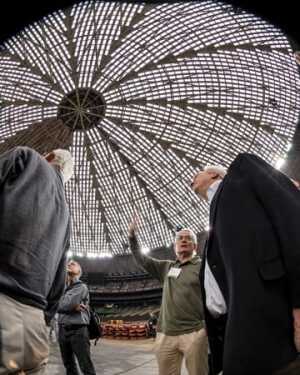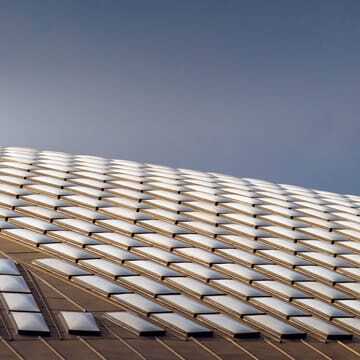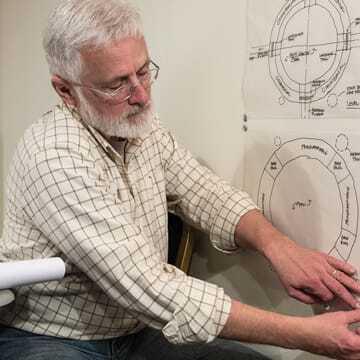Hope has been rekindled for Houston’s Astrodome, a decrepit and dirty stadium that has been vacant for nearly a decade. Its sports teams have moved on to newer, glitzier facilities, and the grand old dome has appeared neglected for years.
Many in Houston have forgotten that the Astrodome was once called the “Eighth Wonder of the World” and that Mickey Mantle hit the first home run there—in an Astros exhibition game with the Yankees on April 9, 1965, with President Lyndon Johnson in attendance.
With no easy answers apparent in the long quest to find a new purpose for the county-owned stadium, some of Houston’s elected and civic leaders now advocate demolition of the dome.
Forgetting the structure’s place in history as the world’s first air-conditioned domed stadium, advocates for quick efficiency see the dome’s removal as a way to provide more event parking for the adjacent football stadium now in use while wiping out what has become an eyesore. For years, the debate has rumbled. Voters turned down a $200 million bond issue in 2013 for redeveloping the dome as a convention center. Another alarm sounded the same year when the National Trust for Historic Preservation named the Astrodome one of America’s 11 most endangered historic places, calling it “a marvel of modern engineering.”
But late in 2014, hope and optimism were reborn when a ULI Advisory Services panel presented its preliminary recommendations on what to do with the Astrodome. At times during the presentation, local residents in the audience broke into applause.
“Our conclusion is the dome can and should live on,” said panel chair Wayne Ratkovich, president of the Los Angeles–based Ratkovich Company, which specializes in urban infill and rehabilitation projects. “You’ve got the Eighth Wonder of the World in your city. You have a wonderful opportunity.”
The ULI panel recommended that the Astrodome be transformed into an indoor urban park—a grand civic space and appealing attraction for the people of Houston and Harris County. The repurposed Astrodome should be greener, the panel said—both more environmentally friendly and thoughtfully landscaped inside and out, verdant with grass and bushes rather than just a sea of concrete paving.

Panelists and stakeholders touring the Astrodome. From Left: Peter Hasselman, an architect and urban designer in Orinda, California; Todd Mead, a senior associate at PWP Landscape Architecture in Berkeley, California; Tom Murphy, former Pittsburgh mayor and ULI senior resident fellow; and Mark Miller, general manager of NRG Park.
The plan is “built upon the idea of a park that’s indoors that makes an outdoor connection and a civic contribution as well,” said panel member Todd Mead, a senior associate at PWP Landscape Architecture in Berkeley, California. “And we need to green up that parking lot so it makes a place for people year-round.”
One striking feature of the new vision presented by the panel is a 100-foot-wide (31 m) grassy promenade lined with oak trees and shade-producing pavilions. The proposed grand entry would lead from the nearby METRO light-rail stop, across what is now a parking lot, and to the heart of the Astrodome.
Located about five miles (8 km) south of downtown, the Astrodome sits amid a vast surface parking lot that covers some 350 acres (142 ha). The dome is adjacent to the hulking 12-year-old NRG Stadium, home to the Houston Texans NFL team and the site of the three-week Houston Livestock Show and Rodeo, which draws 2.5 million people annually.
Even though NRG Stadium has more than 26,000 parking spaces, Houston remains an automobile-dominated city and parking is at a premium during major events. One solution proposed by the ULI panel is creation of two levels of parking under the Astrodome, which was built on a huge, excavated site that placed the playing field 30 feet (9 m) below ground level. Some of the new underground parking would be for cars, and some would be reserved for horse trailers during the rodeo.
The proposal calls for a parklike ground-level space under the roof of the Astrodome, possibly with palletized grass that could be removed to allow use of the dome’s hard floor as exhibition space during conventions, said Mead, the landscape architect.
“We’ve kept a little over 100,000 square feet [9,300 sq m] for lawn or hard surface for exhibition and activities,” Mead said. “It’s about flexibility and creating a green bowl—creating a floor that’s green most of the time and the opportunity for programmable space around the edges.”
The repurposed Astrodome also could be fitted with “adventure park” accoutrements for young people, said panelist Amy Barrett, a planner with the Permar firm in Charleston, South Carolina.
These could include zip lines—allowing adventuresome folks to speed down the equivalent of an 18-story building from the upper levels inside the Dome—as well as indoor rock-climbing walls, hike-and-bike trails, or a skate park. A farmers market, festivals, gardens, and museum exhibits should be considered, Barrett said. And panelists said interior observation decks near the top of the dome are a must.
The dome could also be used to extend the fan experience and tailgating on days when football is played next door.
More serious uses for the Astrodome floor would be as exhibition space for the massive Offshore Technology Conference, an energy convention that comes to Houston every spring.
The ULI plan calls for creation of four portals into the dome, which would allow deliberate connections to the adjacent existing facilities: the NRG football stadium, the 1.4 million-square-foot (130,000 sq m) NRG convention center, and a separate 350,000-square-foot (32,500 sq m) arena used for equestrian shows and smaller events.
The ten-member ULI panel spent nearly a week in Houston interviewing stakeholders and studying the area at the request of Harris County Sports & Convention Corporation, which manages the Astrodome and surrounding facilities. Along with Ratkovich, Mead, and Barrett, the panel included the following ULI members, who volunteered their time and expertise: architect and urban designer Peter Hasselman of Orinda, California; Cary Hirschstein, partner at HR&A Advisors, New York City; Robert Mills, principal at Commonwealth Architects, Richmond, Virginia; Tom Murphy, ULI senior resident fellow and ULI/Klingbeil Family Chair for Urban Development; David Panagore, executive director, New Haven Parking Authority, Hartford, Connecticut; Douette Pryce, president, Pryce Resources, Sewalls Point, Florida; and Kevin Rieger, senior vice president for real estate development, Anschutz Entertainment Group (AEG), Los Angeles.
Harris County Judge Ed Emmett, the top elected county official, said he is eager to receive the ULI panel’s formal, written report. But his initial reaction was positive. “I give this almost a 100 percent chance of succeeding,” Emmett said. “The main thing about this morning’s announcement from the ULI is they unanimously came back and said, ‘Yes, the dome needs to be saved. Yes, it’s usable.’ Now, the hard work begins.”
Emmett said he would love to have the Astrodome ready for use for fan functions when the Super Bowl is played at NRG Stadium in 2017. It is a high priority to at least make the Astrodome presentable before the media spotlight accompanying the Super Bowl focuses on the city, he said.
A preliminary price tag has not yet been established for such a dome transformation, Ratkovich said. But the panel did suggest a multipronged funding program that could include philanthropy, additional corporate sponsorships, a county bond issue, and use of hotel tax funds or historic tax credits—with the involvement of county and city governments and stakeholder tenants, including the rodeo and the Texans football team.
In response to the recommendations, Houston developer Ed Wulfe of Wulfe & Company, which specializes in retail and mixed-use projects, said, “The plan challenges our community’s leadership to come together as probably never before to cooperatively and creatively formulate and involve many and far-ranging sources of financing to make the plan possible. It’s an opportunity of a lifetime.”
Wulfe, a longtime civic leader and past chairman of ULI Houston, said the panel produced a “comprehensive yet fungible plan that imaginatively offers unlimited possibilities. It brilliantly includes and connects existing and future components and adds new concepts beautifully.”
The ULI study was funded by the Harris County Sports and Convention Corporation in conjunction with the National Trust for Historic Preservation.
Long ago, beginning with discussions that involved some consultation with futuristic thinker, architect, and inventor Buckminster Fuller, the Astrodome was conceived as a way to bring air-conditioned Major League Baseball to Houston, where brutal afternoon heat, humidity, and frequent monsoon-like rains dampened the potential for fan appeal. Designed by architects Hermon Lloyd and W.B. Morgan, and the firm Wilson, Morris, Crain, and Anderson, the Astrodome was the “world’s biggest room” when it opened in 1965 after three years of construction, with a roof spanning 600 feet (183 m) and no columns supporting it.
Innovation was in the air in Houston in the early 1960s. President John F. Kennedy had challenged the nation to land an astronaut on the moon before the end of the decade. Houston was nicknamed “Space City,” and astronauts trained at the new National Aeronautics and Space Administration (NASA) facility in southeast Houston.
The space theme bled into the marketing at the Astrodome, where employee uniforms borrowed design elements from astronaut space suits and female ushers were called Spacettes. But more important, the audacious domed stadium development effort, led by former mayor Roy Hofheinz, shared a can-do entrepreneurial spirit with NASA’s space exploration.
Whether it was engineering the stadium’s complex air-conditioning system that required 300-foot (91 m) “throws” of chilled air or solving the ceiling’s glare problem that temporarily blinded ballplayers in the outfield soon after opening, the dome effort demonstrated an unconquerable spirit that is part of Houston’s character. When natural grass would not grow on the playing field, the dome operators worked with Monsanto to create Astroturf, a synthetic surface that was soon coveted by other stadium owners.
The domed stadium itself was soon copied by other cities, too, as roofed stadiums appeared in New Orleans, Detroit, Minneapolis, and elsewhere.
“The Astrodome is significant for its architecture,” says architecture historian Stephen Fox, author of Houston Architectural Guide. “It was the first roofed, air-conditioned sports stadium of this magnitude in the world. It set a pattern for subsequent roofed sports stadiums. So it was a precursor of an important building type significant in the United States in the last quarter of the 20th century.”
Some of the world’s greatest athletes, including baseball legends Willie Mays and Nolan Ryan, and pro football Hall of Famer Earl Campbell, played at the Astrodome, which housed the Houston Astros and Houston Oilers. Some of the greatest performing artists appeared onstage there as well, including Elvis Presley, Judy Garland, Bob Dylan, and George Strait. But perhaps the dome’s finest hour came in 2005, when it opened to shelter thousands of evacuees from New Orleans following Hurricane Katrina.
Proponents of bulldozing the dome do not seem to understand the structure’s significance.
To locals opposed to razing the Astrodome, the structure is not simply an old sports stadium. They see it as part of Space City, an extension of Mission Control’s exploration into new frontiers. To them, it embodies Houston’s can-do spirit of innovation, entrepreneurship—nothing less than a symbol of the soul of Houston.
Ralph Bivins, a native Houstonian, is editor of Realty News Report.










